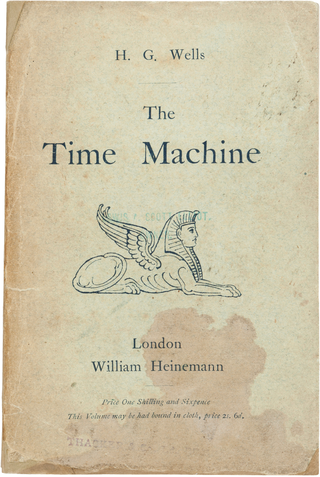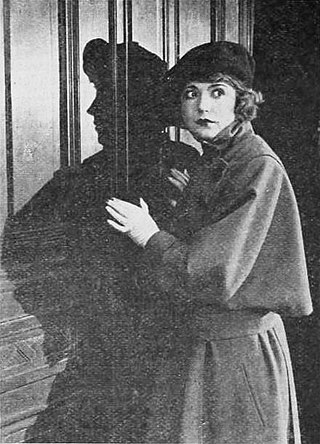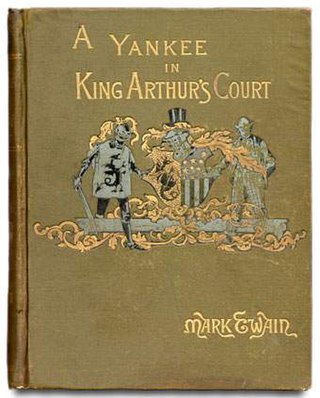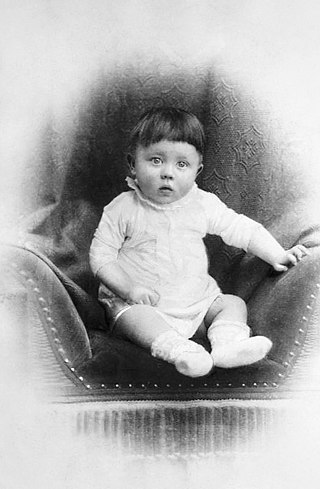
Time travel is the hypothetical activity of traveling into the past or future. Time travel is a widely recognized concept in philosophy and fiction, particularly science fiction. In fiction, time travel is typically achieved through the use of a hypothetical device known as a time machine. The idea of a time machine was popularized by H. G. Wells's 1895 novel The Time Machine.
The Novikov self-consistency principle, also known as the Novikov self-consistency conjecture and Larry Niven's law of conservation of history, is a principle developed by Russian physicist Igor Dmitriyevich Novikov in the mid-1980s. Novikov intended it to solve the problem of paradoxes in time travel, which is theoretically permitted in certain solutions of general relativity that contain what are known as closed timelike curves. The principle asserts that if an event exists that would cause a paradox or any "change" to the past whatsoever, then the probability of that event is zero. It would thus be impossible to create time paradoxes.

The End of Eternity is a 1955 science fiction novel by Isaac Asimov with mystery and thriller elements on the subjects of time travel and social engineering. Its ultimate premise is that of a causal loop, a type of temporal paradox in which events and their causes form a loop.

Science fiction is a film genre that uses speculative, fictional science-based depictions of phenomena that are not fully accepted by mainstream science, such as extraterrestrial lifeforms, spacecraft, robots, cyborgs, mutants, interstellar travel, time travel, or other technologies. Science fiction films have often been used to focus on political or social issues, and to explore philosophical issues like the human condition.

Retrofuturism is a movement in the creative arts showing the influence of depictions of the future produced in an earlier era. If futurism is sometimes called a "science" bent on anticipating what will come, retrofuturism is the remembering of that anticipation. Characterized by a blend of old-fashioned "retro styles" with futuristic technology, retrofuturism explores the themes of tension between past and future, and between the alienating and empowering effects of technology. Primarily reflected in artistic creations and modified technologies that realize the imagined artifacts of its parallel reality, retrofuturism can be seen as "an animating perspective on the world".
The time loop or temporal loop is a plot device in fiction whereby characters re-experience a span of time which is repeated, sometimes more than once, with some hope of breaking out of the cycle of repetition. The term "time loop" is sometimes used to refer to a causal loop; however, causal loops are unchanging and self-originating, whereas time loops are constantly resetting: when a certain condition is met, such as a death of a character or a clock reaching a certain time, the loop starts again, possibly with one or more characters retaining the memories from the previous loop.
A Tipler cylinder, also called a Tipler time machine, is a hypothetical object theorized to be a potential mode of time travel—although results have shown that a Tipler cylinder could only allow time travel if its length were infinite or with the existence of negative energy.
A plot twist is a literary technique that introduces a radical change in the direction or expected outcome of the plot in a work of fiction. When it happens near the end of a story, it is known as a twist ending or surprise ending. It may change the audience's perception of the preceding events, or introduce a new conflict that places it in a different context. A plot twist may be foreshadowed, to prepare the audience to accept it, but it usually comes with some element of surprise. There are various methods used to execute a plot twist, such as withholding information from the audience, or misleading them with ambiguous or false information. Not every plot has a twist, but some have multiple lesser ones, and some are defined by a single major twist.
A temporal paradox, time paradox, or time travel paradox, is a paradox, an apparent contradiction, or logical contradiction associated with the idea of time travel or other foreknowledge of the future. While the notion of time travel to the future complies with the current understanding of physics via relativistic time dilation, temporal paradoxes arise from circumstances involving hypothetical time travel to the past – and are often used to demonstrate its impossibility.
The timestream or time stream is a metaphorical conception of time as a stream, a flowing body of water. In Brave New Words: The Oxford Dictionary of Science Fiction, the term is more narrowly defined as: "the series of all events from past to future, especially when conceived of as one of many such series". Timestream is the normal passage or flow of time and its historical developments, within a given dimension of reality. The concept of the time stream, and the ability to travel within and around it, are the fundamentals of a genre of science fiction.

Suspense is a state of anxiety or excitement caused by mysteriousness, uncertainty, doubt, or undecidedness. In a narrative work, suspense is the audience's excited anticipation about the plot or conflict, particularly as it affects a character for whom the audience feels sympathy. However, suspense is not exclusive to narratives.
In science fiction, a time viewer, temporal viewer, or chronoscope is a device that allows another point in time to be observed. The concept has appeared since the late 19th century, constituting a significant yet relatively obscure subgenre of time travel fiction and appearing in various media including literature, cinema, and television. Stories usually explain the technology by referencing cutting-edge science, though sometimes invoking the supernatural instead. Most commonly only the past can be observed, though occasionally time viewers capable of showing the future appear; these devices are sometimes limited in terms of what information about the future can be obtained. Other variations on the concept include being able to listen to the past but not view it.

The hypothetical particles tachyons, defined through being faster than light, have inspired many occurrences in fiction. In general, tachyons are a standby mechanism upon which many science fiction authors rely to establish faster-than-light communication, with or without reference to causality issues, as well as a means to achieve faster-than-light travel. Science writer Sidney Perkowitz commented "that the very word "tachyon," because of its unusual Greek-origin spelling and engagingly catchy hard "ch" sound, lends a certain "science-ness" or "science coolness to fiction." Starting in the 1970s, tachyons were used in science-fiction to present a seemingly-plausible explanation for time travel and communication through time. Peter Nicholls, in The Encyclopedia of Science Fiction, describes Gregory Benford's Timescape (1980) as the first work to use tachyons to this effect "with some care", where scientists send a message to the past trying to change history. Glen Cook's 1985 novel A Matter of Time features a much less stringently described "tachyon generator" to "transmit [both to the past and] to the far future". Uses of the concept for space travel appeared in association with "the Asgard, the benevolent alien race in the Stargate SG-1 television series (1997–2007)", and in the 2001 film K-Pax, which coined the term "tachyonic speeds" for "multiples of light speed". An "unabashed" use appeared already in 1969, where "Bob Shaw's The Palace of Eternity features such delights as a million-ton tachyonic spaceship travelling at 30,000 times the speed of light." In the Star Trek franchise, in addition to facilitating faster-than-light travel, tachyons have been mentioned "for varied purposes, including cloaking a spacecraft, detection" of such cloaking and overcoming defensive shields, which has been regarded as "technobabble" by Mashable contributor Keith Wagstaff: dialogue that implies a scientific explanation, using a term with a real scientific concept behind it, "but really doesn't mean much."
Retrocausality, or backwards causation, is a concept of cause and effect in which an effect precedes its cause in time and so a later event affects an earlier one. In quantum physics, the distinction between cause and effect is not made at the most fundamental level and so time-symmetric systems can be viewed as causal or retrocausal. Philosophical considerations of time travel often address the same issues as retrocausality, as do treatments of the subject in fiction, but the two phenomena are distinct.
The idea of a fourth dimension has been a factor in the evolution of modern art, but use of concepts relating to higher dimensions has been little discussed by academics in the literary world. From the late 19th century onwards, many writers began to make use of possibilities opened up by the exploration of such concepts as hypercube geometry. While many writers took the fourth dimension to be one of time, others preferred to think of it in spatial terms, and some associated the new mathematics with wider changes in modern culture.
"The Clock That Went Backward" is a fantasy short story by American writer Edward Page Mitchell.

A time slip is a plot device in fantasy and science fiction in which a person, or group of people, seem to accidentally travel through time by unknown means, or by a means unknown to the character(s).

Killing baby Hitler is a thought experiment in ethics and theoretical physics which poses the question of using time travel to assassinate an infant Adolf Hitler. It presents an ethical dilemma in both the action and its consequences, as well as a temporal paradox in the logical consistency of time. Killing baby Hitler first became a literary trope of science fiction during World War II and has since been used to explore these ethical and metaphysical debates.







